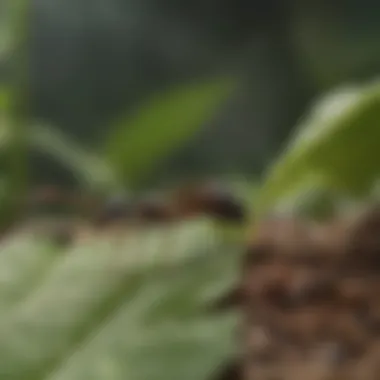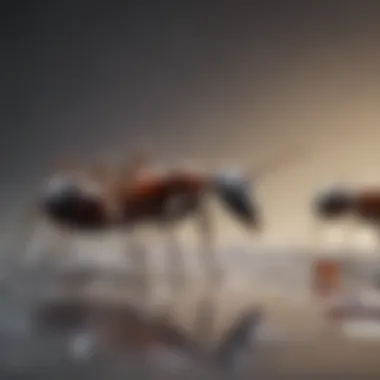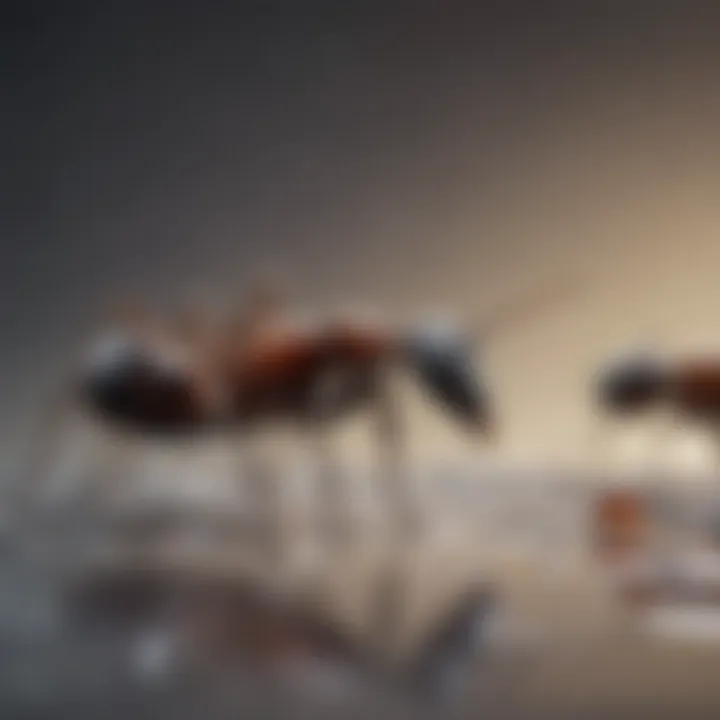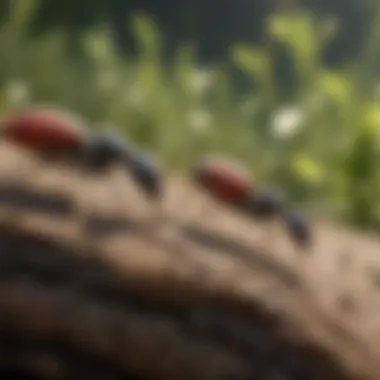Exploring the Dietary Patterns of Ants and Their Roles


Intro
Understanding the Pest
To comprehend the dietary habits of ants, it is crucial to recognize their role as pests in some contexts.
Identification
Ants belong to the Formicidae family and are present in nearly every habitat on Earth. They can be identified by their segmented bodies, elbowed antennae, and generally small size. Different species exhibit distinct colors, sizes, and nesting behaviors, which can aid in identification. Common household ants include the Carpenter ant, Argentine ant, and Odorous house ant. Understanding the identification characteristics of these pests can help homeowners gauge their potential impact.
Life Cycle
The life cycle of ants consists of four stages: egg, larva, pupa, and adult. The queen ant lays eggs, which hatch into larvae that are fed by worker ants. Once grown, these larvae pupate before emerging as adult ants. This process can take several weeks to months, depending on the species and environmental conditions. The life cycle significantly impacts their dietary needs at different stages, making them adaptable feeders to ensure survival.
Dietary Patterns of Ants
Ants display diverse feeding habits influenced by their species, environment, and ecological roles.
Ants primarily consume:
- Sugars: Many ants are attracted to sugary substances. This includes nectar from plants, honeydew produced by aphids, and decaying fruits.
- Proteins: Protein sources, such as other insects and meat, are crucial for growth and reproduction.
- Fungi: Leafcutter ants cultivate fungi as a food source, showcasing a unique symbiotic relationship in their diet.
- Seeds: Some species, like harvester ants, gather seeds and store them for later use.
The dietary choices of ants not only shape their survival strategies but also influence their interactions with other organisms.
Pest Prevention Strategies
Once the dietary habits of ants are understood, developing effective pest prevention strategies becomes essential for homeowners.
Environment Modification
Altering the environment can disrupt ants' access to food sources. Simple strategies include:
- Eliminating food sources: Keep kitchens clean and store food in sealed containers to prevent ants from foraging.
- Removing nesting sites: Trim vegetation near structures and ensure that wood piles are stored off the ground.
Physical Barriers
Creating barriers can effectively minimize ant entry:
- Sealing cracks: Use caulk or other materials to seal entry points around windows and doors.
- Installing screens: Ensure all windows and doors have tight-fitting screens to keep ants out.
The End
Intro to Ant Diets
Ants are found in vast environments across the globe, ranging from the arid deserts to lush rainforests. Their food sources are as varied as their habitats. This nutritional diversity is by no means trivial; it shapes their behaviors, influences colony dynamics, and directly affects their role in nutrient cycling and ecosystem maintenance.
A thorough exploration of ant diets covers not just what they eat but also why certain foods are essential. Dietary needs can fluctuate with environmental conditions and species types, which drives ant foraging behavior and resource allocation within colonies.
The relevance of investigating ant diets extends further into applications for homeowners. By understanding what attracts ants and how they contribute to or disrupt daily life, effective pest management strategies can be formulated.
The Role of Diet in Ant Biology
Diet is fundamental to ant biology. It affects growth, reproduction, and overall colony health. Ants are social insects; thus, the diet they provide to their queen and larvae can dictate the reproductive success and longevity of the colony. During specific life stages, such as larval growth, ants require high-protein diets. Conversely, sugars and carbohydrates may be favored by adult ants for energy.
Certain ant species possess physiological adaptations to exploit their chosen food sources efficiently. For example, leafcutter ants cultivate fungi, relying on this symbiotic relationship to meet their protein needs. Different diets enable ants to thrive in specific niches, creating a complex web of interdependence within their ecosystems.
"Ants demonstrate a remarkable ability to adapt their diets based on the availability of resources, underscoring their role as resilient ecological players."


Diversity of Ant Species and Their Diets
The diversity of ant species is mirrored by their diverse dietary habits. Ants can be classified into various categories based on their dietary preferences. Some are strict herbivores, while others are predators or scavengers. This variety informs their ecological role and interactions.
- Herbivorous ants often focus on seeds, nectar, and plant exudates. For instance, many species rely on honeydew, a sugary substance secreted by aphids, as a significant food source.
- Predatory ants, such as fire ants or army ants, tend to hunt other insects or arachnids. Their diets exhibit a predilection for high-protein content, which is essential for colony nourishment and growth.
- Scavenging ants, like the common pavement ant, capitalize on scraps of food from human activities or decaying organic matter.
Ants exhibit a variety of foraging behaviors that reflect their dietary diversity. Scouting, recruitment, and resource allocation strategies differ greatly among species, all shaped by their nutritional roles and needs. This level of adaptability is a testament to their evolutionary success. Understanding these dietary preferences aids in appreciating the complex relationships ants maintain within their environments and the implications these relationships have for pest management and ecological health.
Primary Food Sources for Ants
The dietary habits of ants are notably diverse, influenced by both their biological makeup and environmental conditions. Understanding the primary food sources for ants illuminates their nutritional needs and role within the ecosystem. These sources mainly include sugars, carbohydrates, proteins, and lipids. Each of these categories contributes uniquely to ant health and colony sustainability.
Sugars and Carbohydrates
Natural Sap
Natural sap is a key energy source for many ant species. It consists of a mixture of sugars, water, and essential nutrients that ants utilize for energy. The accessibility of sap from trees makes it a vital resource, especially for those ants that live in close proximity to trees. Sap’s high sugar content offers rapid energy, which is crucial for foraging and colony activities. The unique feature of natural sap is its direct role in ant communication, as some ants engage in mutualistic behavior with certain trees, promoting sap production. A disadvantage, however, is that not all ant species can readily access this resource.
Honeydew from Aphids
Honeydew, a sugary substance excreted by aphids, is another significant food source for ants. Ants often engage in protective behaviors for aphids, safeguarding them from predators to ensure continual access to honeydew. This relationship demonstrates a symbiotic interaction where both species benefit. Honeydew is a popular food because it is concentrated in sugars, making it an efficient energy source. It is also produced in large quantities under favorable conditions. However, over-reliance on honeydew can lead ants to neglect other essential diets, thereby affecting their growth and resilience.
Fruits and Vegetables
Fruits and vegetables serve as supplementary food sources for ants, providing both sugars and essential vitamins. Many ant species collect and store plant material, such as fruits, as food reserves. This behavior contributes to their diet diversity and colony nutrition. The advantage of fruits and vegetables is their abundance and variety, which can help ants adapt to seasonal changes. On the downside, they can be perishable and may not offer the concentrated energy found in other sources, potentially requiring seasonal strategies from ant colonies to optimize their storage.
Proteins and Lipids
Insects and Other Arthropods
Insects and other arthropods are rich in protein and lipids, making them critical for ant nutrition. Many ant species are predatory or scavengers, actively seeking out these protein sources. Hunting or collecting dead insects ensures that ants receive the essential nutrients for growth and reproduction. A key characteristic is the ability to exploit various arthropods, which offers flexibility in their diet. However, dependence on live prey can be unpredictable, depending on environmental factors.
Seeds and Grains
Seeds and grains are another important protein and energy source. Ants harvest seeds from their environment, storing them for later use in their nests. This behavior supports their survival during lean periods. The primary benefit of seeds is their high energy content, particularly in the form of carbohydrates. Additionally, seeds remain stable over time, allowing for long-term storage. On the flip side, seeds may require special adaptations for foraging and storage that not all ant species possess.
Animal Remains
Animal remains often serve as a vital food source for many ant species. They scavenge dead or dying animals, which provide proteins and fats. This scavenging aspect plays a role in nutrient cycling within ecosystems. The unique feature of this food source is its contribution to cleaning up the environment, reducing decay. Still, locating animal remains can be opportunistic, making it a less predictable food source compared to living prey or plant-based diets.
Specialized Diets Among Ant Species
Understanding specialized diets among ant species provides insight into their ecological roles and adaptations. This section focuses on how certain ant species have developed unique feeding behaviors to thrive in specific environments. Specialized diets enable ants to occupy distinct niches, thereby enhancing their survival and success in various ecosystems.
Leafcutter Ants
Fungus Cultivation
Leafcutter ants, particularly species like Atta and Acromyrmex, engage in a complex behavior known as fungus cultivation. This process involves cutting leaves and transporting them back to the colony. Once there, they chew the leaves into a pulp and use it as a substrate for growing a specific type of fungus. This fungus serves as their primary food source.
The key characteristic of fungus cultivation is its efficiency. The mutualistic relationship between the ant and the fungus is fascinating. The ants depend on the fungus for food, while the fungus benefits from the continual supply of organic material and protection provided by the ants. This relationship highlights the advantages of specialization in ant diets, providing a consistent and reliable food source.
A unique feature of fungus cultivation is its contribution to nutrient cycling in the ecosystem. Leafcutter ants play an important role in the decomposition of plant material, which enriches the soil. However, this specialization also comes with disadvantages. If the supply of suitable leaves decreases, it may significantly affect the fungus and, in turn, the ants' survival.
Symbiotic Relationships
Symbiotic relationships among leafcutter ants and other organisms are vital for their success. These ants often engage with various microorganisms that help them digest the tough plant material they feed on. This aspect of their diet demonstrates adaptation to their environment.


The key characteristic here is interdependence. Ants provide a habitat for the microorganisms, while the microorganisms assist in breaking down the plant matter, making nutrients more accessible. This interplay is essential for maintaining a healthy colony structure.
A unique feature regarding symbiotic relationships is their variability. These ants can adapt to different species of fungi, which allows them to capitalize on a range of available plant materials. However, this can also lead to vulnerability. If an ant species becomes too reliant on one type of fungus, it may face challenges if environmental conditions change or if the fungal partner is damaged.
Carpenter Ants
Wood and Plant Materials
Carpenter ants, such as Camponotus, primarily consume wood and plant materials. They do not eat the wood itself but excavate it to create nests. This behavior leads to a varied diet as they also gather honeydew from aphids and forage for proteins.
The key characteristic to note is their nesting behavior. By creating nests within wood, carpenter ants provide essential benefits to their colonies, such as protection from predators. Furthermore, they contribute to the decomposition of dead trees, playing a significant role in their ecosystems.
A unique feature of their preference for wood is its availability in forested areas. This can be an advantage during specific seasons. However, wood as a food source limits them to certain habitats, which may restrict their expansion.
Bark and Sap
Carpenter ants also consume bark and sap, which provide sugars and carbs vital for energy. They will often target trees where aphids are present, as these pests can be a significant source of honeydew.
The important aspect of this diet is its flexibility. By exploiting multiple resources, carpenter ants can adapt to changing conditions. This versatility allows them to thrive in diverse environments.
A unique feature of consuming bark and sap is their role in the ecological balance. While they may benefit from these resources, overexploitation can lead to tree health issues. Therefore, their diet should be understood in the context of ecosystem management.
Ant Foraging Behavior
Ant foraging behavior is critical for understanding how different species optimize their food searches and resource management. The strategies ants employ when foraging significantly influence their diets and overall colony success. By studying their behaviors, one can gain insights into their adaptive mechanisms to environmental changes and food availability. This section explores two fundamental aspects of ant foraging—scouting and recruitment strategies, as well as colony resource allocation.
Scouting and Recruitment Strategies
Ants utilize various scouting and recruitment strategies to efficiently locate and gather food. Scouting involves individual ants venturing out to explore their surroundings for potential food sources. Once a food source is discovered, the uncovering ant may transport a small portion of the food back to the colony. During this return trip, it often leaves a pheromone trail that signals other ants to converge on the newly found resource.
This pheromone trail acts as a kind of communication, allowing for rapid recruitment of fellow workers to the food source. The intensity of the trail can indicate how rich the food resource is; stronger trails attract more ants. As new ants follow the trail, they also contribute to the pheromone deposit, enhancing its efficacy.
Some notable aspects of scouting behavior include:
- Variation in foraging conditions: Depending on the environment, ants may shift their strategies.
- Species diversity: Different ant species display unique parameters in scouting that align with their ecological niches.
- Learning behavior: Ants can learn from previous foraging successes, optimizing their search patterns over time.
Colony Resource Allocation
Resource allocation within an ant colony reflects a well-organized system necessary for survival, especially when foraging for food. A colony must balance its resources to ensure efficiency while maximizing nutritional intake. Ants allocate various roles within their hierarchy, leading to specialized tasks such as foragers, soldiers, and nurse ants. Each role plays a pivotal part in how the colony accesses and shares food resources.
When a substantial food source is found, resource allocation also involves decision-making processes that determine how many ants to send out, how to divide the food, and how to protect it from other organisms, such as competitors or predators.
Key points of resource allocation include:
- Efficiency: Workers use information regarding the food source to plan trips accordingly.
- Division of labor: Some ants may focus on guarding food while others gather it.
- Adaptation: Colder or harsher environments can lead to altered foraging behaviors, impacting resource allocation.
Effective foraging behavior enables ants to thrive in diverse habitats, ensuring sustained colony health.
Understanding these behaviors is invaluable. It not only highlights how ants contribute to ecosystems but also reveals potential methods for managing ants in both natural and urban settings. Homeowners can benefit from this knowledge, especially in developing pest control strategies that minimize damage while recognizing the ecological importance of these creatures.
Ecological Impact of Ant Diets
The dietary habits of ants have a profound influence on ecosystems. Ants are not just foragers; they are active participants in their environments. Their feeding behaviors govern plant growth, soil composition, and the distribution of nutrients. Understanding the ecological impact of ant diets offers insightful perspectives on biodiversity and the health of ecosystems. For homeowners, comprehending how ants contribute positively can mitigate undesired pest perceptions.
Nutrient Cycling
Ants play a crucial role in nutrient cycling. Their activities contribute to the breakdown and decomposition of organic materials. By feeding on dead insects, plant materials, and other organic debris, ants facilitate the recycling of nutrients back into the soil. This process enriches the soil, promoting plant growth and biodiversity.


"Ants are nature’s recyclers, turning waste into nutrients that support thriving ecosystems."
In their nests, ants often gather a significant amount of organic matter. When this matter decomposes, it releases nutrients that plants absorb. This dynamic interaction underscores the necessity of ants in maintaining soil health. Moreover, ant foraging behavior can lead to the aeration of the soil, which improves its structure and enhances water retention.
Ants as Ecological Engineers
Ants also act as ecological engineers in various ways. They shape their environments through their feeding and nesting behaviors. For example, leafcutter ants cultivate fungus as their primary food source. In the process, they prune leaves, affecting the structure of the vegetation around them.
Ants can also influence the distribution of other species. By seed dispersal, they assist in plant reproduction, which in turn supports other wildlife. Their nests provide habitats for various organisms, contributing to overall ecosystem diversity.
In urban settings, understanding the role of ants helps in pest strategy development. Recognizing ants as beneficial organisms rather than merely pests can lead to more symbiotic interactions between them and residential spaces.
Through their dietary choices and subsequent ecological roles, ants are central to the health and functionality of ecosystems.
Ants in Pest Management
Ants play a complex role in pest management. Their diverse dietary patterns influence how they interact with both other insects and their environments. Understanding this dynamic can help homeowners and professionals alike develop effective strategies for pest control.
Ants can act as biological control agents. They prey on many pest insects that can harm gardens and homes. For instance, some ant species feed on the larvae of harmful pests, preventing outbreaks. Their presence can limit the population of aphids and caterpillars. This natural predation contributes to ecological balance in the environment. As such, promoting ant populations in specific settings can act as an efficient pest management strategy.
Moreover, ants build intricate colonies that disturb pest habitats. For example, their nesting activities aerate the soil and contribute to nutrient cycling. Well-aerated soil can be healthier for plant growth, helping create environments less hospitable to some pests.
However, managing ant populations requires careful consideration. While they can be beneficial, some species can invade homes, causing disturbances. Homeowners need to learn how to manage these populations effectively without harming the ants' ecological roles. Strategies may include:
- Identifying which ant species are beneficial versus problematic.
- Implementing barriers and sanitation improve household conditions.
- Utilizing targeted pesticides only in situations of severe infestations.
Successful pest management not only requires an understanding of ant behavior but also a commitment to monitoring their impact on local ecosystems.
Ants as Biological Control Agents
In the insect world, ants can be among the most effective biological control agents available. Their predation habits allow them to control populations of various pests, contributing to pest management in gardens and urban settings. Ants aggressively defend their territory, often leading them to attack and consume insects like aphids and larval caterpillars. This form of pest control does not depend on chemical pesticides, which can have harmful effects on other insects and the overall environment. Ants also contribute to nutrient cycling and soil health; their tunneling activities promote better drainage and aeration in soil. This has indirect benefits for gardens and plants, making them healthier and more robust.
Maintaining a healthy ant population in your environment can thus support natural pest management strategies.
Managing Ant Populations in Urban Settings
Ants may become a nuisance in urban areas, particularly when they invade homes and structures. Effective management requires understanding the species and their behavior. Not all ants are harmful; many can be beneficial. However, when they enter homes or buildings, homeowners may need to take steps to control them.
Various methods can be implemented for this purpose:
- Prevention: Start by sealing cracks and openings. This makes it harder for ants to enter your home.
- Regular Cleaning: Keeping food stored properly and cleaning up crumbs reduces attractants for ants.
- Natural Deterrents: Utilizing substances like vinegar or diatomaceous earth can help discourage ants without using harsh chemicals.
- Soil Health: Encouraging a healthy outdoor ecosystem can limit the chances of ant colonies seeking shelter indoors.
Homeowners should also recognize the importance of the surrounding area. An exterior monitoring strategy can inform management decisions about when to intervene against invading ants. By managing their presence thoughtfully, one can reap the benefits ants provide while minimizing their potential to become pests.
The End
In the study of ant diets, it becomes evident that their varied dietary habits play a significant role in the ecosystems they inhabit. The conclusion of this article synthesizes key insights into the dietary diversity among ants and illustrates how these patterns influence ecological interactions, human pest management strategies, and even the sustainability of our environments.
Summary of Dietary Diversity
Ants exhibit a rich tapestry of dietary preferences, spanning from sugars to proteins. This diversity allows them to occupy various ecological niches effectively. For instance, some ants rely heavily on sugars found in honeydew produced by aphids or nectar from flowers, while others focus on protein sources such as insects or seeds. This mixed diet is not merely about survival; it shapes their behavior, colony structure, and interactions with other organisms.
Understanding the specific dietary needs and behaviors of different ant species can illuminate how they contribute to nutrient cycling and ecosystem balance. Homeowners might find this knowledge essential, as it can guide effective pest management. For example, attracting beneficial ants may mitigate the presence of unwanted pests without chemical treatments.
Future Directions in Ant Diet Research
As we look to the future, research in ant diets should delve deeper into how environmental changes impact these dietary sources. Climate change and urbanization are shifting the availability of food resources, which in turn affects ant behavior and population dynamics. Key areas for future exploration include:
- Impact of Climate Change: Assessing how altered weather patterns influence food sources.
- Urban Ecosystems: Understanding how ants adapt to and thrive in urban environments, particularly regarding human-related food waste.
- Nutritional Requirements: Investigating the specific nutritional needs of various ant species and how these influence colony health.
By exploring these dimensions, researchers can provide vital insights that contribute to ecological theory and practical applications in pest management, thus enriching our understanding of ants' roles in both natural and human-influenced environments.
Moreover, recognizing the intricate relationships ants have with other organisms and their surroundings encourages more sustainable practices among homeowners and pest control professionals. This holistic approach to studying ant diets not only helps in addressing current ecological issues but also ensures that future challenges can be met with informed strategies.







